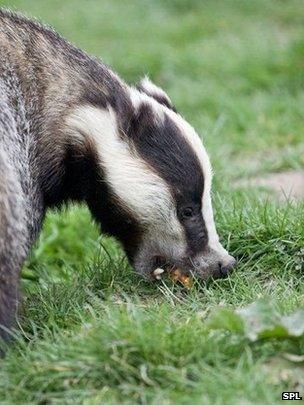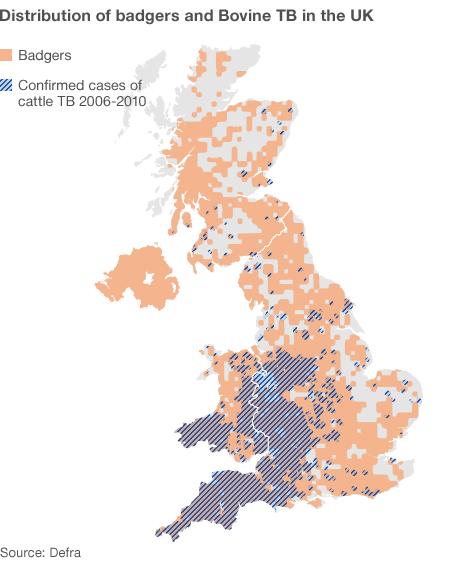Badger cull: A stay of execution?
- Published

Radically changed badger population estimates have contributed to the most recent controversy
Controversial government plans to cull thousands of badgers have been delayed amid questions over the cost and effectiveness of the scheme.
Environment Secretary Owen Paterson's Commons statement confirmed speculation that a pilot cull in the south-west of England is to be put back until next year.
The aim of the pilot trials was to assess whether culling of badgers in Gloucestershire and Somerset would be able to deliver a significant reduction in the cattle TB rate.
If, after a six-week period, these trials were shown to be effective in killing enough badgers, humane licences for culls would have been rolled out across parts of England.
That plan has now been delayed until next year following the realisation late in the day by ministers and farming groups that there are twice as many badgers as previously thought, making it difficult if not impossible for farmers to kill enough badgers in time to affect cattle TB rates.
The environmental agency Natural England granted two provisional licences: one in September and one in early October for culls of badgers in the pilot areas.
Culling could not begin until full licences were granted. These would be issued once Natural England was satisfied that farming groups in each of the areas had put up the money for a six-week cull to be held annually for four years, in a bid to to kill at least 70% of the badgers in the pilot areas.
However, last week it emerged that a census of the badger population in each of the areas showed there were twice as many badgers in each area than previously thought.
Last Thursday, the Agriculture and Food Minister David Heath MP gave the results of the census in a Parliamentary answer: 3,600 badgers in Gloucester and 4,300 in Somerset.
The marksmen employed to shoot the badgers were reported to be paid a bounty per badger and so the new population estimate meant that the cost of the cull in both pilot areas would be sent soaring.
It became apparent last week these developments increased the cost of the cull for farmers. The Environment Secretary Owen Paterson, Mr Heath and the government's chief veterinarian Nigel Gibbens were due to give a series of coordinated interviews but pulled out at short notice.
There is speculation that ministers spent the weekend urging farming groups in the pilot areas and National Farmers Union (NFU) not to pull out of the cull so as to avoid another embarrassing "U-turn" for the Government.
Mr Paterson has denied that the decision is a U-turn, stating it is a delay and that he remains committed to the cull.
But it is not apparent how the problems can be overcome in a year's time.
Farming groups will want to know why the Department for Food and Rural Affairs (Defra) and Natural England got the estimate for badger numbers so badly wrong.
A spokesman for Natural England said: "Licences were issued in full knowledge that they would remain provisional until the maximum and minimum numbers were authorised - based on the final population data and agreed methodology."
"The minimum and maximum numbers were calculated based on survey work undertaken by Defra, which has enabled us to estimate the badger population in each area. To increase our confidence in these population estimates, information from other fieldwork has also been used."
The cull has been controversial. Many scientists have questioned whether the cull is practical or able to deliver more than a modest decrease in cattle TB rates.

- Published23 October 2012
- Published23 October 2012
- Published28 September 2012
- Published18 October 2012
- Published16 October 2012
- Published14 October 2012